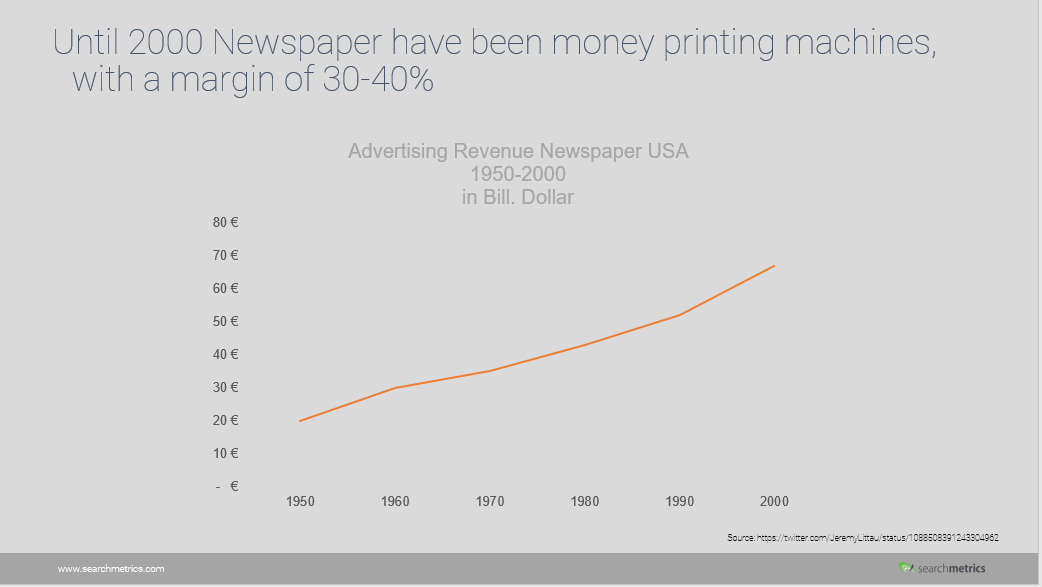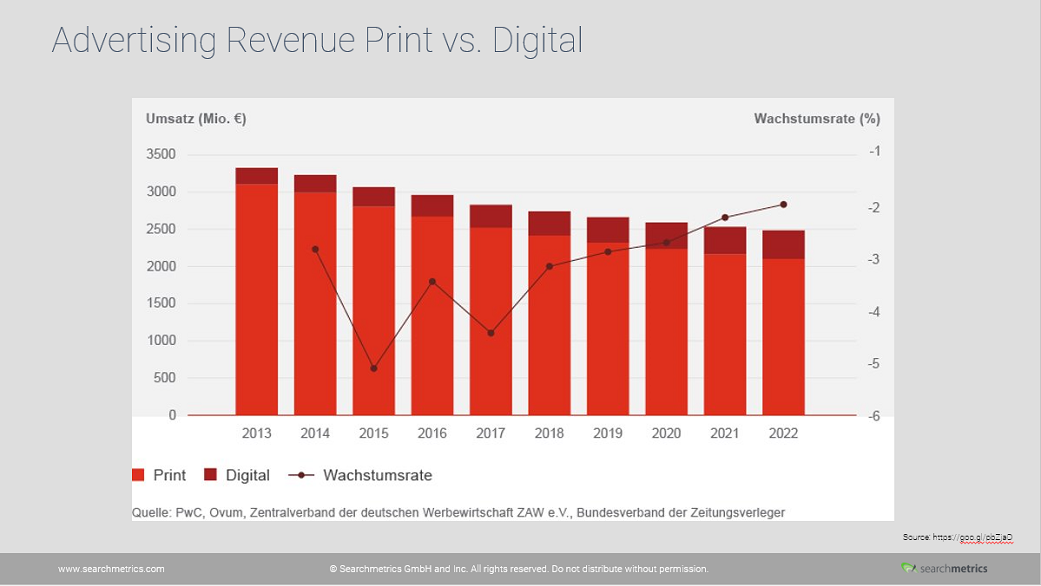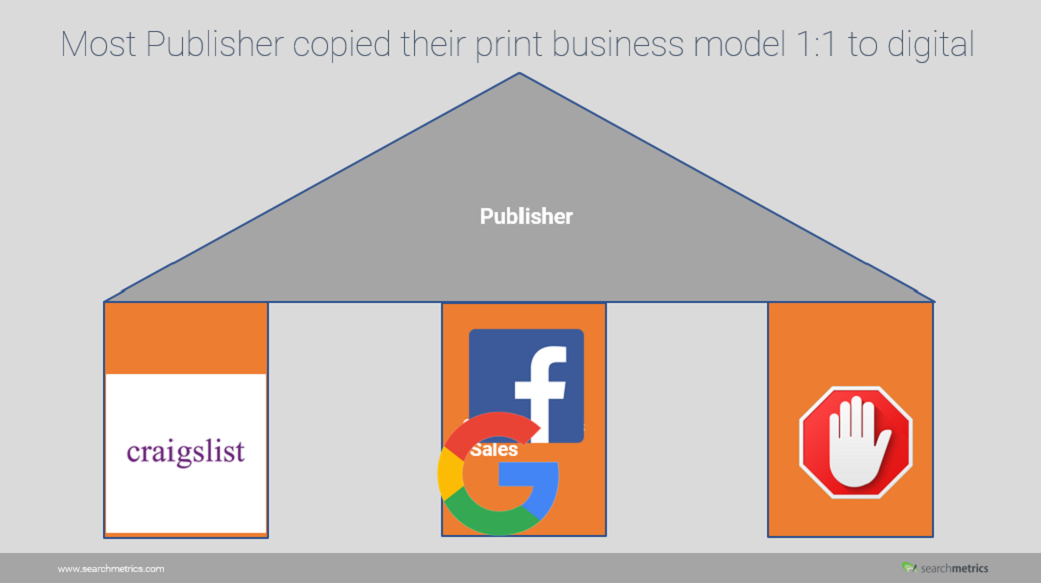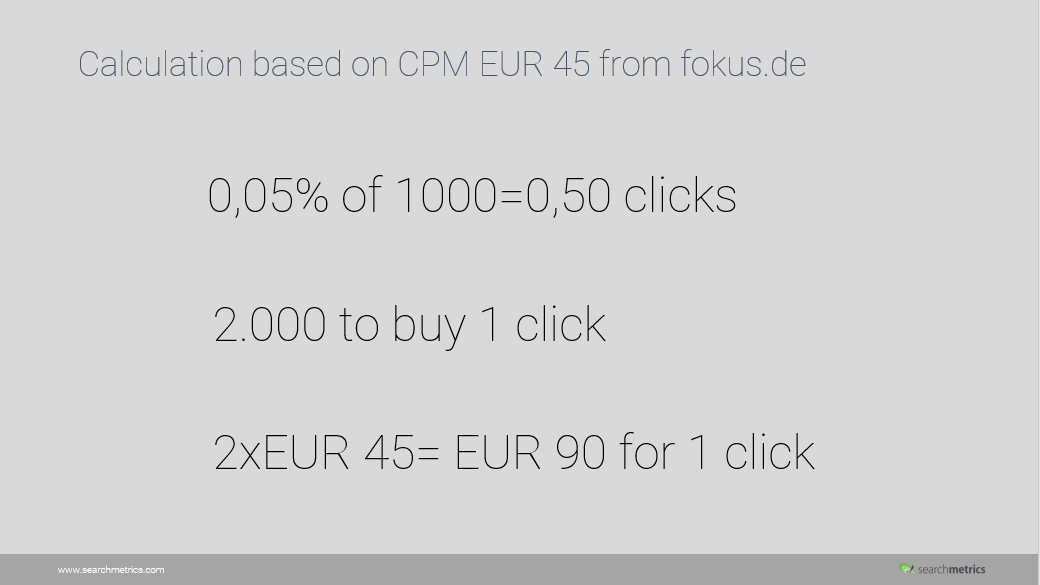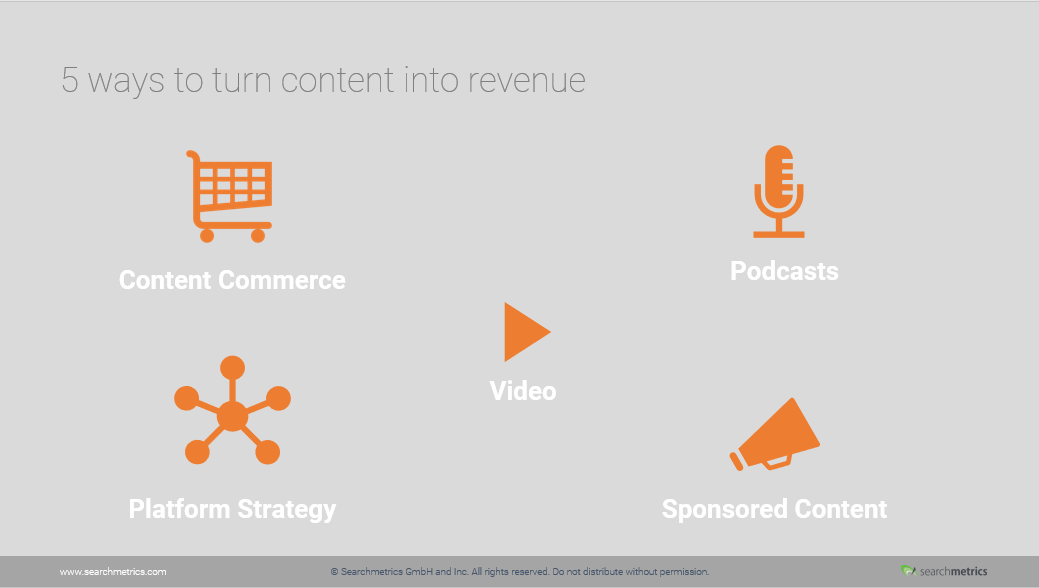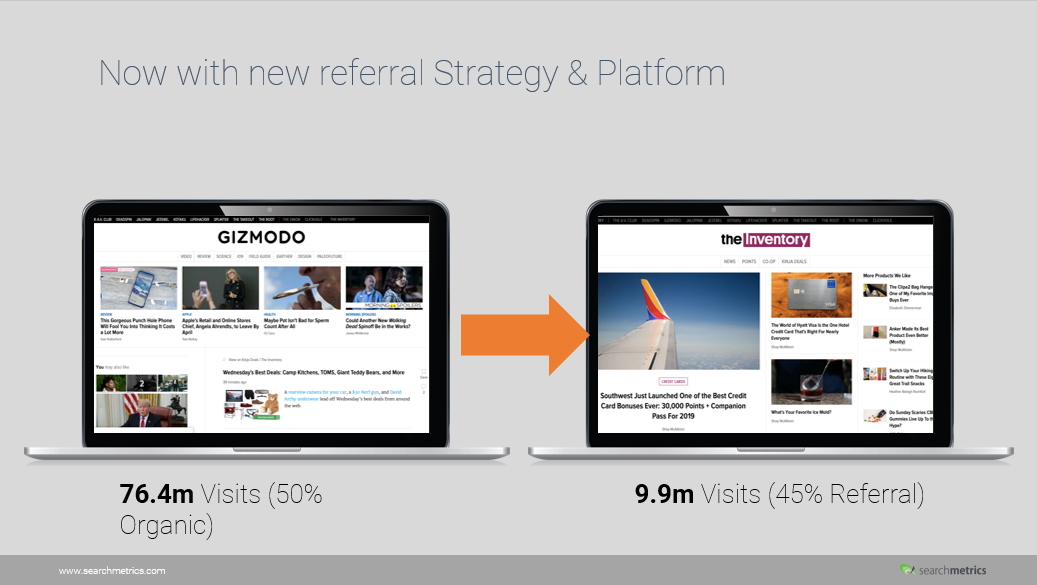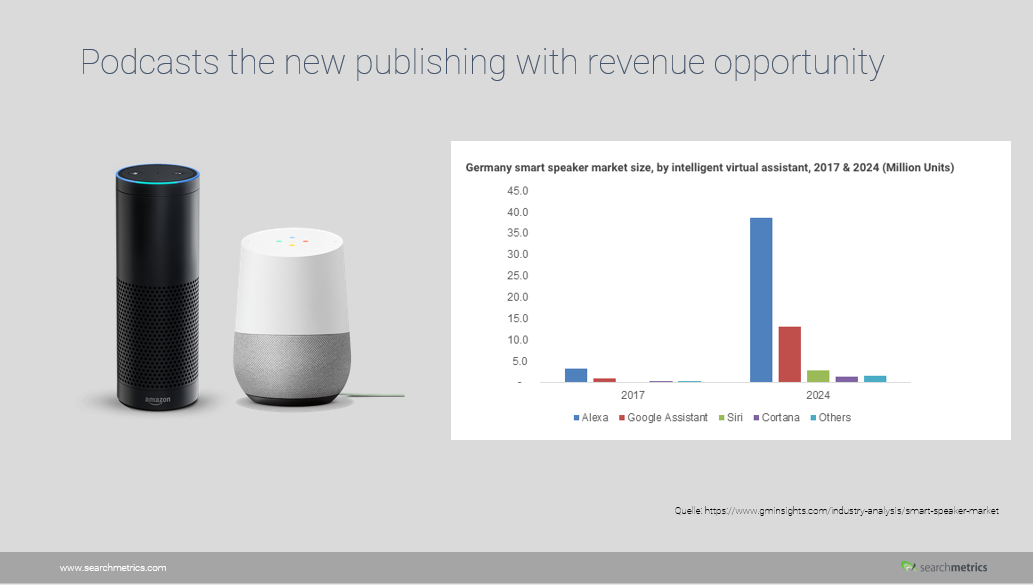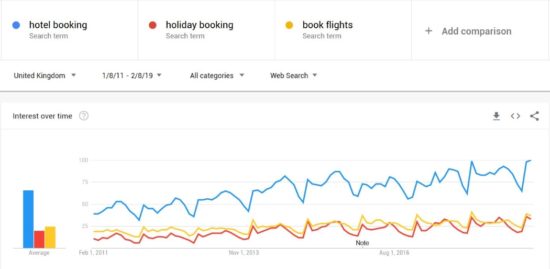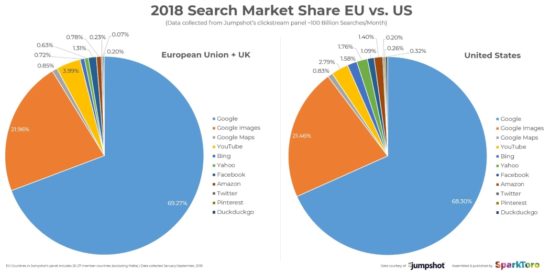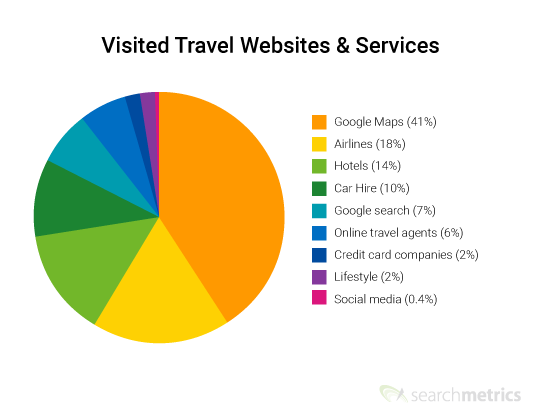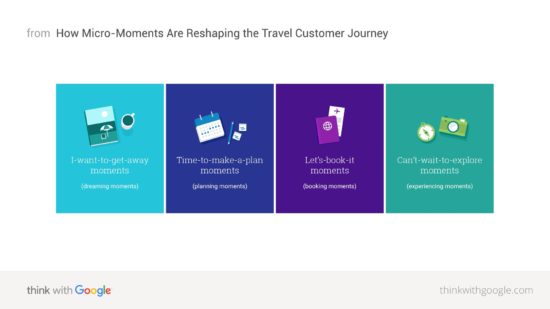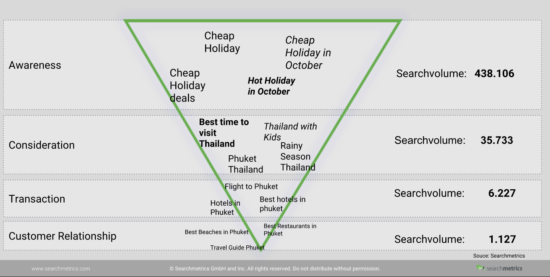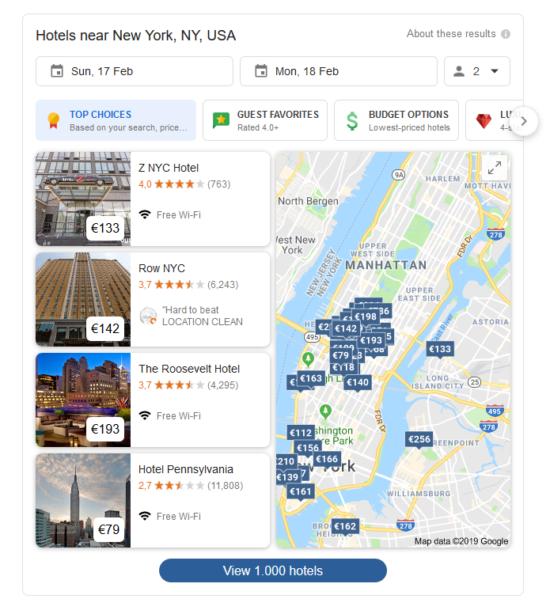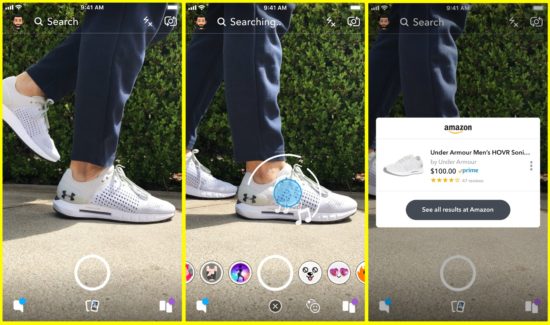White label seo services news.
Another piece of content just created by Searchmetrics SEO Blog . Likely to be among the best suppliers of free website content online.
Episode Overview
We’re thrilled to be hosting Robert Rose, the Content Marketing Institute’s Chief Strategist and one of the Content Marketing Industry’s leading thinkers. In this episode, Ben and Robert discuss the growing fragmentation of content, driven by omni-channel marketing strategies as well as the growth and evolution of the industry as a whole. Tune in to understand what’s next and how to leverage cutting edge trends to improve your content marketing efforts.
//html5-player.libsyn.com/embed/episode/id/8793338/height/90/theme/custom/thumbnail/yes/direction/backward/render-playlist/no/custom-color/87A93A/
iTunes Overcast Spotify Stitcher
Episode Transcript
Ben: Welcome back to content month on the Voices of Search Podcast. I’m your host, Benjamin Shapiro, and today we’re going to continue our month-long deep dive into the words behind the numbers and discuss what SEOs need to know about content creation, publishing, and optimization. Joining us today is a very special guest, Robert Rose, who is according to his LinkedIn profile bother the chief strategist and chief troublemaker at the Content Marketing Institute which is a resource that helps marketers maximize their content marketing efforts by teaching them how to attract and retain customers through compelling, multichannel story telling. Today Robert is going to talk to us about the current landscape of the content marketing industry.
Ben: But before we get started, I want to remind you that this podcast is brought to you by the marketing team at Searchmetrics. We are an SEO and content marketing platform that helps enterprise scale businesses monitor their online presence and make data driven decisions. To support you, our loyal podcast listeners, we’re offering a complimentary digital diagnostic. A member of our digital strategies group will provide you with a consultation that reviews how your website, content, and SEO strategies can be optimized. To schedule your free digital diagnostic go to Searchmetrics.com/diagnostic.
Ben: Okay. Here is our conversation with the one and only Robert Rose, chief troublemaker and chief strategist at the Content Marketing Institute.
Ben: Robert, welcome to the Voices of Search Podcast.
Robert: Well thanks so much for having me. It’s awesome to be here. I’ve been a listener of the show for some time and it’s awesome to be on it actually.
Ben: We’re thrilled to have you here, I’m thrilled to have you here, and I’m also excited to talk to a fellow chief troublemaker.
Robert: Well, you know, as I usually introduce myself it’s I’m generally overhead. If I’m not throwing a bomb into the middle of the conference room table I’m generally pretty useless.
Ben: When I first met Jordan Koene, the CEO of Searchmetrics and one of the hosts of this show, his official business card at E-bay said that he was the CIO, chief infographics officer.
Robert: That’s a good one. I have one of mine where someone asked me my title one time and I said, “The bringer of gravitas”.
Ben: Love it. Very presidential of you.
Robert: There you go.
Ben: Well we’re really excited to have you here and really excited to wrap up our content marketing month by talking to you about which way the content marketing industry is headed. Let’s start off by doing a quick review. Tell us a little bit about how you got into the content marketing industry and how has it changed since you started?
Robert: Sure. Well, and it’s changed a lot. I’ve been in marketing now, I’m coming up on my, and I have the gray hair to show it, I’m coming up on 30 years of working as a marketer. And what happened was I was a CMO of a software company in the early 2000s, as I like to say, way before cloud was cool. And it was overall pretty much a struggle and pushing a rock up a hill and all of that. We were trying to introduce new terms and new ideas into a very classically built infrastructure of install software and as a CMO I was trying to figure out how to become a little more innovative with marketing and one of the things that I decided was when they put those millions of dollars on my desk and said, yeah go do that thing called marketing, is that I would do something a little different.
Robert: I would, instead of trying to compete with IBM and HP and Microsoft at the time, and Oracle, and all of these huge software companies that would always beat us in SEO and definitely beat us in any kind of spend that we would do, I was just going to be deeper. We were going to be the expert in our space. And so I didn’t hire marketing people, I hired content creators and designers and communicators and I turned this into a little bit of a media company. And the reason for that was quite simply because I wanted us to be a mile deep so when we did get to the table, we got a better shot of actually winning the customer because we would be seen as the thought leaders in the space. And my hunch and my hypothesis was, I can teach them how to be marketers, I can teach them how to do an A/B test, I can teach them how to a call to action, but I can’t teach them how to be great writers and great media producers. And it worked. And so over the course of eight years the company grew and we did a nice little thing and basically became the thought leader in the space.
Robert: And then I was out telling my story in 2008, 2009 timeframe and I met this guy, Joe Pulizzi, and he was basically giving the same presentation I was. I had read his book, of course, Get Content Get Customers, and he and I had dinner and became just fast friends immediately. We both saw things from the same perspective and him from a little bit of a difference in that he was a publisher and came from a publishing point of view and I came from more of a marketing practitioner point of view. He was just starting this thing and he said, “Hey, listen, if you ever decide to be done with the software company we should do something together, I’m starting this thing called The Content Marketing Institute and we’re gonna evangelize this thing called content marketing”. And I said, “Well, it just so happens” dot, dot, dot, and the rest, as they say, is history. I sort of latched onto this idea of helping businesses figure out how to operationalize this thing just like I had in my company and figure out the right people and functions and strategy to really operationalize content as a strategic function. And I’ve been doing that since 2009.
Ben: I want to talk a little bit about your experience at the software company and try to relate it back to SEO terms where you were competing against install base software companies with a larger chip stack, more money to spend, and your strategy was to create a high volume of content that was, I think you called it almost a publication.
Robert: That’s right.
Ben: To me that is you creating the long tail, right? Trying to relate this back to SEO by having a high volume of content that covers a wide breadth of very detailed subjects. Do you refer back to what your strategy was back then, can you relate it to SEO terms? Were you specifically trying to create content that wasn’t being touched or was it about volume, timeliness, and velocity?
Robert: The strategy at the time was sort of two pronged. One of the things that I did specifically in SEO, one of the challenges that I even saw in the early days of SEO was I would hire, because I was certainly not an expert, so I would hire SEO, quote unquote, consultants to come in and teach me and my team on how to do this, and the thing that they kept saying that just never made any sense to me was you need to pick your keywords, make a list, and then we’re going to go spend the next nine months or twelve months ranking for those key words.
Robert: And the thing that never made any sense to me was we were going to spend nine to twelve months ranking for these key words and quite frankly in twelve months they may be gone, they may be out of style, they may be not what everybody is searching for, especially in the business that I was in which was quite frankly a very evolving and fluid industry. This was software as a service, cloud computing, we used to call them ASPs and MSPs and trying to distinguish ASP which was active service provider, versus ASP in programming language. We had a number of keyword challenges and people weren’t really searching for it yet but they were searching for things that they were seeing and so what we did with that was a little different was we started making bets on keywords and keyword lists that didn’t rank today but that we could own in nine to twelve months. In other words, building a content and media strategy that would be hopefully, and we were wrong as often as we were right, that would actually be what people were searching for a year from now or nine months from now.
Robert: So we took a very forward leaning approach with our SEO strategy and then buffeted it with this idea that quite frankly what we were trying to create was truly evergreen content, best practices, thought leadership, leading thought, so that because the business we were in was all about a moment of change and that moment of change can sometimes come for an enterprise software buyer not for six months. In other words they may have a moment to build a budget for this and then it gets canceled or they may build a budget and then something else comes up and it gets delayed. And so it wasn’t about trying to find buyers in any one moment, it was building a platform that would find buyers and keep them engaged so that when that moment then arose we would have them engaged and ready to have a discussion. It was truly nurturing a market so that we would be ready for them when they were ready for us.
Ben: I think that’s an interesting takeaway for the SEO community is that as you are developing your SEO strategies thinking about the landscape and trying to build a keyword list that’s going to be valuable when you actually have the opportunity to rank for it. And if you think it’s going to take six to nine months to rank for a keyword then you should try to pick something that’s future looking as opposed to something that you need now. I like how you position the time value of your SEO work.
Ben: Talk to me a little bit about The Content Marketing Institute, the asset that you’ve developed with Joe Pulizzi and what does that do?
Robert: Well Content Marketing Institute was started by Joe as a media company. And when he started it it was all about evangelizing the practice of content marketing as an approach, as a methodology for marketing, and it’s still that to this day. And when I joined my sort of influence if you will was to sort of bring the more practitioner side of it. Joe had come from the publishing side as I’ve mentioned and basically brought a lot of the best practices. I still learn things from Joe today about how media businesses operate, how publishers operate, they’re so applicable to what we do in marketing today.
Robert: But the thing that I could bring is what was really happening in big companies when it came to the practitioner’s point of view or the point of view of content in an enterprise, the politics, and the silos, and the technology, and all of the things that sort of rear their head. And together we really started CMI as sort of a resource that would be available for all of these marketers in typically larger businesses. How to sort out what all of the issues would be in making content marketing a more successful practice. And that’s when we launched the business that I run which is of course the education and consulting piece of it and that’s mostly what I do. And then the media operation which was the event primarily, The Content Marketing World which happens in September each year, and of course our blog if you want to call it that but it’s really more than a blog at this point, our website which is really just a resource and a daily news source of content marketing goodness.
Ben: So it’s a multichannel business where you’re creating content yourself as educational content, you’re doing consulting, and you have an event, I imagine that you work with a lot of content creators mostly on the consulting side. Tell me a little bit about how the content marketing industry has been changing and what are some of the big factors that are influencing marketers, and maybe even if you can talk specifically about what are some of the factors that might be effecting SEOs.
Robert: I think the biggest evolution that I have seen is, as Joe used to like to say, we are in the early innings of this as a strategy in the business. And I think that’ still true today. What we’ve seen over the last, call it six or seven years, and the SEOs in your audience will appreciate this, they typically do when I talk about this where the important of content, original, value delivering content, and I don’t necessarily just mean ad copy, and web copy, and email copy, and stuff like that, I mean stuff that is supposed to deliver value in and of itself, content that is-
Ben: Articles.
Robert: Yeah, exactly the increasing importance of that has become unquestioned. There is now really no argument that a business shouldn’t do this to some extent. You can argue about how much and quantity versus quality and there are certainly lots and lots of debates that happen around that but the idea that it should exist somewhere in the business has sort of been put to bed. Now the question is, and this is the challenge that quite frankly I most often saw and where we sort of sit today, is that what has evolved is personal skill sets or what I call random acts or ad hoc content pockets within the business. So the demand generation team has a strategy, the PR team has a strategy, the brand team has a strategy, the web team has a strategy, everybody, I call it the Oprah effect of content. Everybody gets a content marketing strategy. And as such we’ve launched a million blogs, we’ve launched websites, we’ve got 900 landing pages out there, we’ve got all of these elements of content that quite frankly are a mess and aren’t very focused and don’t have a lot of purpose around them.
Robert: Sadly, in many cases the SEO professionals are left trying to optimize all of that and continually saying in meetings, we should cut down on the piece of content here because we need to focus here and we’re not optimizing here or we should be optimizing there, and its big ball of untangled twine right now. And so what we see is that businesses are finally starting to realize that and the landscape today that we see out there are, especially in larger enterprises, finally making the discovery that content as an enterprise strategic and at some level central function to the business is as important as product development. And so getting our arms around the creation, management, optimization, and measurement of content is a critical thing. And that’s the real challenge these days is who should it, what does the team look like, how does it play out, where is the strategy, what’s the channels that we’re going to be on, and getting out of this sort of mentality of, yay everybody needs content so let’s just produce as much as we can of it, throw it up against the wall and see what sticks, and rather getting much more media operation like, figuring out what is the direct purpose and focus of the experiences we’re trying to create for customers at various parts of their journey and be really good at delivering.
Ben: So, Robert, I guess one of the things that I have a question about is, what’s really driving the increase in importance of content? People have been writing blog posts since the dawn of the internet era and now it seems like there is a shift sort of away from a focus on paid advertising for a lot of brands, and more focus on these sort of experiential advertising campaigns and that affects content. What’s driving the increased importance of content as a marketing channel?
Robert: Well I think you see a couple of things, right, which is at a tectonic scale we see fragmentation. We see fragmentation across, the term du jour is omni channel. So we see social media, television, print, online, your Apple watch, the screen in front of you in a car, all of this fragmentation of audiences and where they’re spending their screen time and how they’re consuming content, and thus you see a real … I mean, look, we’re spending as much money as we did on paid advertising before but the purpose and the platform of it is evolving significantly.
Ben: The overall impression levels have gone up.
Robert: Of course. Of course. And we’re spending a lot to get there. And we can have a wonderful discussion around the efficacy of that and bots and fraud and NGPR and where all of that is going, but the ultimate net result of it is an increased importance on creating content that delivers value and quite frankly starts to deliver trust earlier in the relationship. And so differentiating whether you’re Nike and you’re going to create a Colin Kaepernick ad and all of the content around that, and you’re going to pay for some placement of that, some of that content you’re going to pay for placement for, but the goal of it is to differentiate you in a way that develops trust in the brand going forward instead of saying buy now, buy now, buy now, buy now. And the same goes for the website, the same goes for email, the same goes for social media, especially as it becomes a more paid oriented platform. The importance of good content rises in importance as the need to pull trust forward with consumers has become such an important thing with the fragmentation of audiences and the lack of attention and really any kind of brand loyalty that might exist.
Ben: What I’m hearing is that we’re being advertised to more often, in more different places because we have our smartphones and just putting a performance-based banner ad in front of somebody and saying buy something doesn’t do the trick like it used to because people are always being advertised to and we’re desensitized to that. So the way to reach consumers is to build trust and build relationships with them and that’s where content is a better vehicle than sort of the traditional format of advertising.
Robert: Yeah. I mean a great example of this is you look at Edelman’s trust barometer and you look at just trust generally in the mainstream media. And so if you look at that and you compare numbers and I’ll get these numbers slightly wrong but let’s say they’re in the high 30s, low 40s where trust in mainstream media and the facts and information that we’re being given is generally where consumers are these days and that’s an extraordinarily low number, and you can feel it, we don’t have to have research to tell us that we don’t have a ton of trust in mainstream media these days but that goes across the board. That’s not just one or two networks or one or two content platforms. That’s across the board of media, broadly speaking, consumers are being advertised and sold to not only in paid advertising but of course in the content itself in many ways and the distrust has grown highly because of it.
Robert: Let’s not forget that in the sixties and the seventies, let’s remember we’re talking Watergate era, trust in mainstream media was in the high 70s and low 80%. So it has come down markedly. And while that says not so wonderful things about where we are culturally right now, it is an extraordinarily big opportunity for us as brand marketers and marketers to create that trust. It’s a low bar right now and so starting to create trust earlier in the process and differentiation in what we deliver and our point of view on the world and what we stand for is the opportunity to be the trusted source of interesting things is to become Amazon, it is to become Netflix, it is to become Disney, it is to become Starbucks, USA Today, and then translate it out to [inaudible 00:20:45], IBM, and all of the companies that are creating value through their content programs that are ultimately pulling trust forward and building an audience that believes in what they stand for.
Ben: Yeah, it’s interesting, what I’m inferring from what you’re saying is that the process used to be sell, sell, sell, sell, sell, once somebody is your customer build the relationship with them. And now it has to be build the relationship, sell, cultivate the relationship.
Robert: That’s exactly it. Because that’s where we have the opportunity. I’ve talked about this before but this idea it used to be about attention and as marketers we have been classically trained at university to conflate attention and trust. In other words, time spent on site or we look at how much attention we’ve gotten in a television rating or a TV commercial and in many ways that attention could be at least correlated to some success measure. That’s no longer true with trust as low as it is. Attention is not the same as trust. And I can be loud, and I can be noisy, and I can get somebody’s attention, and it can be for very, very, very bad things and that will not affect in a good way my marketing results. And so that’s the opportunity.
Ben: Talk to me about best practices for content marketing and specifically when you talk about how marketers and SEOs build that trust to make their content effective.
Robert: Honestly it starts with good content and I know that’s a circular argument. It’s like, hey how do you create content that people trust, create trustworthy content. But I think beyond that what we have to do is figure out a way, because what happens in business so often I find is that we get into this content, it’s just like we were talking about at the top of the show, which is we get into this mentality in business of, hey content works, this stuff works. And so what happens is without a purpose and focus, a strategic purpose and focus behind content as a function people look at content as an alternative to a piece of collateral material or a catalog or an advertisement and start measuring it as such and that’s the wrong way to measure it. If we start measuring it like that we will ultimately fail because content, good content, quality content, trustworthy content, is harder to create than an ad or a piece of collateral or a catalog.
Robert: And so it has to start with this, what experience are we trying to build for a customer at whatever part of the journey we’re looking to build this experience, and what would that mean if we could pull trust forward here, like if going out of this experience they trust us a little more deeply, if they give us a little more information because they want to give us more information, if they convert in a little higher preponderance because they really start to become more deeply involved or invested in our point of view, what does that look like and how do we do that in a concerted way where we don’t have to pay attention to the noise of sales going, hey make the logo pop more, or we go, hey we’ve got to put a call to action in here, or, hey there aren’t enough mentions of the product in this. How do we get to a point where our focus becomes audience centric and developing trust. And if we can’t start there we’ll never get there because the pressure then to create persuasive ad copy, marketing product heavy content is just too great.
Ben: I hear what you’re saying in the sense of how building trust is important and I guess the thing that sticks out to me is that authenticity is an increasingly important thing where you build trust by getting across the point that you are someone that is knowledgeable and that there is no ulterior motive or no hidden motive to you creating the piece of content that you’re creating. Who is doing a good job building content, what are some of the examples that you point to of somebody that’s doing a nice job building trust? And if you can think of, maybe tie in what their SEO strategies might be or how they’re implementing it that would be wonderful.
Robert: Well let me give you a couple. And I’ll tie at least one of them into SEO because one I actually know what they’re doing on SEO and the other one I don’t. Of course the quintessential example of the trust, and I love this case study, is what Red Bull does. And we often talk about Red Bull. I mean you can’t go to a content marketing conference and not hear Red Bull mentioned. But the thing that I love about what Red Bull does is first of all it’s not only a focused strategy for them, it’s an entire division. It’s a company. It makes money. They add money to the bottom line. They sell advertising, they sell sponsorships. Red Bull media house is the main marketing arm of Red Bull but more importantly, it’s a focused business strategy for them. Now here’s the thing about the trust, they have done the research into what their audience that shows. So first of all we’re going to both have to agree that Red Bull tastes like crap, I mean it’s just a horrible, horrible tasting drink and we need to agree on that.
Ben: For the sake of the podcast, sure. I don’t think it tastes terrible. It’ll just kill you.
Robert: It’s really bad.
Ben: Okay.
Robert: And so. It’s Jägermeister bad.
Ben: Well no, that’s the Jägermeister that you’re tasting, it’s not the Red Bull.
Robert: Fair enough. Fair enough. The other thing is that it’s the most expensive soft drink in the soft drink aisle typically. And so what they’ve done the research to show is that people who have either tried Red Bull and don’t like it or people who have never tried Red Bull will actually recommend Red Bull to their friends because of the value that they’ve gotten out of the content that they’ve received from Red Bull. Now that’s not an SEO story, that is a trust being delivered at the very top of the funnel with an audience that either doesn’t know you or knows you and tried you and didn’t like you. Imagine getting recommended for your product from a customer who has either never tried your product or quite frankly has tried it and was dissatisfied with it but they get so much value out of the content that you’ve created a trust, a level of trust that, you know what, I didn’t like it but somebody, my friend, might so I’m going to recommend it to them. That’s a powerful story.
Robert: Now, on the SEO side, I would point to a lot of what the company Indium is doing. Indium is a solder supply company selling soldering and soldering equipment. And they’re not a big company, they’re a mid-sized company. They have 23 different blogs, each one fronted with an engineer in front of it, and they have a complete SEO strategy for all of the different flavors of soldering and soldering equipment and that’s why they have 23 separate blogs for each flavor of soldering, each fronted by a particular engineer. And they call it there from one engineer to another. And they ostensibly just answer every single question a soldering engineer is going to have about an experiment they want to run but don’t have time to run it. Now, they answer every single question, they don’t publish the answer to every single question but they publish most of it. And all of those blogs, by the way, are now translated into six different languages.
Robert: So, if you said to me, who’s the biggest media company in soldering, I would tell you it’s not a media company, it’s Indium. And the wonderful thing about that is it not only works from a search and from just a general ranking perspective, but it works from a trust perspective as well as these are engineers who come to trust the answers and information they get from Indium whether or not it has anything to do with their product and many times the content quite frankly doesn’t.
Ben: The last question I have for you is, you’ve been a marketer for 30 years, you’ve been at The Content Marketing Institute for, I won’t say it too loudly but, a decade.
Robert: Highlight my age why don’t you.
Ben: Well you look great for being 35. That’s all I’m gonna say.
Robert: You’re very, very sweet.
Ben: You’ve seen changes in the value of content as a marketing channel, if you can read the tea leaves and look into the crystal ball, what do you see being the future of content marketing? What direction are we heading next?
Robert: I think there’s a couple of different directions. I think one, I think the interesting thing I find in the SEO space is broadening out because honestly the last, and search engine professionals quite frankly are way more out ahead of this than I am, but what I’ve noticed is that in many cases what SEO became for a lot of companies was they just should call it GEO, so it was Google optimization. And it is so much more than that. I know companies in manufacturing that have entire SEO practices that are focused on Amazon and that are focused on Target, and Walmart. And I know other SEOs that are really focused in on social and how to optimize against YouTube. And that I think the growth of that has been really inspiring to me and I think it’s such an important piece as the web evolves itself and turns into voice search activated and other sort of big channels that we would normally think of as the web itself, IE Facebook or Amazon, et cetera, how search is really such an important component of building access to us as a brand. That I think will continue to expand and become a much more interesting expansion. Quite frankly I find that much more interesting than I find sort of the buzz around artificial intelligence and all that crap.
Robert: But on the same side I see this idea of as we build out these experiences, whether we call them publications or blogs or websites or email newsletters or thought leadership hubs or whatever they are, getting more focus around the value and the sort of platform like integration into the business is where I see the next sort of step for most businesses as they take them. It’s sort of what I was talking about at the top of the show, sort of evolving out of that siloed mentality of content and getting much more into a how do we make content flow through our business like blood, like water, so that we can control how much better it can be used, and control the costs around it. Those are all short term things that I see businesses really focused on.
Robert: Longer term down the road, yes, artificial intelligence, machine learning, content creation at scale, all that stuff is going to become I think fairly interesting but right now it’s just a mosquito noise around everybody’s head and sadly I think marketers have too much attention on it right now.
Ben: It’s the new shiny thing in front of us.
Robert: Of course. Of course. And there will be a lot of over purchase of software as a result of it. But I think one of those things, I can’t remember who it was, I want to say it was, it might have been Andy Hall or somebody like that who, it was a great quote so I’m misattributing it for sure. But it basically said, before we go buy the new thing we should probably get good at the old thing.
Ben: Yeah. Definitely true. I do think that it’s interesting that you find the verticalization of search beyond just Google into video content and ecommerce, YouTube, and Amazon, more interesting than AI. Any other last upcoming, future trends that you think are interesting or that SEOs should be aware of.
Robert: Well you bring up video and I think that’s an incredibly important one. The web is becoming much more video based and along with that comes not only the text but the audio and even the search around imagery. I used to have a really good friend of mine and they in fact worked at the software company that I told you about who was just an amazing computer scientist and had all kinds of sort of [inaudible 00:33:20] for searching against imagery and using that for robotics and I think that’s another part of search that’s truly interesting is having search recognize images and how do you start optimizing image creation to be better found on search. And that includes video as well.
Ben: It’s something that we’ve actually focused on a fair amount at Searchmetrics where we are an SEO and content marketing platform but a big part of our marketing strategy is producing audio content, this podcast, and we’re using that and transcribing it and basically repurposing different mediums of content to produce valuable trustworthy ways to reach out with our consumers across multiple mediums and I do think that there is something to be said about video becomes audio, audio becomes text, text becomes searchable.
Robert: Yes. Exactly right.
Ben: Okay. Well Robert it’s an honor and a privilege to have you on the podcast, thank you so much for making the time. It’s been a pleasure to talk to you and I hope that everybody that’s listening appreciates that Robert is absolutely an influencer in the content marketing industry and, like I said, we’re very excited to have you on the show.
Robert: Thank you so much. What a fun discussion this was.
Ben: Great. Well glad to have you on and that wraps up this episode of the Voices of Search Podcast. Thank you for listening to my conversation with Robert Rose, the chief content strategist and chief troublemaker at The Content Marketing Institute. We’d love to continue this conversation with you so if you’re interested in contacting Robert you can find a link to his LinkedIn profile in our show notes, you can send him a tweet where his handle is @Robert_Rose, or you can visit his company’s website which is contentadvisory.net. If you have general marketing questions or if you’d like to talk about this podcast you can find my contact information in our show notes or you can send me a tweet @benjshap. If you’re interested in learning more about how to use search data to boost your organic traffic, online visibility, or to gain competitive insights head over to searchmetrics.com/diagnostic for your complimentary advisory session with our digital strategies team. And if you like this podcast or you want a regular stream of SEO and content marketing insights in your podcast feed hit the subscribe button in your podcast app and we’ll be back in your feed next week. Lastly if you’ve enjoyed this podcast and you’re feeling generous we’d love for you to leave us a review in the Apple iTunes store or wherever you listen to your podcast.
Ben: Okay, that’s it for today. Thanks again to Robert Rose for joining us. And until next time remember the answers are always in the data.
Let’s block ads! (Why?)
First posted on this site Searchmetrics SEO Blog
Hope you enjoyed that information that they provided. You will discover similar articles on our main site: https://rankmaster.rankmysite1st.com
Let me have your feedback below, leave a comment and let us know which topics you would like us to cover in our articles.








